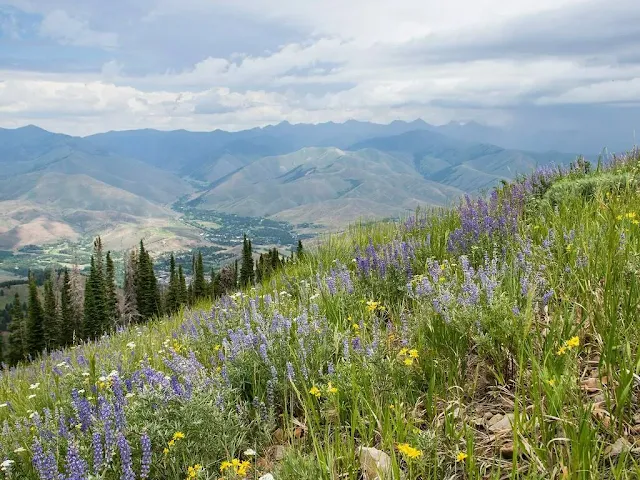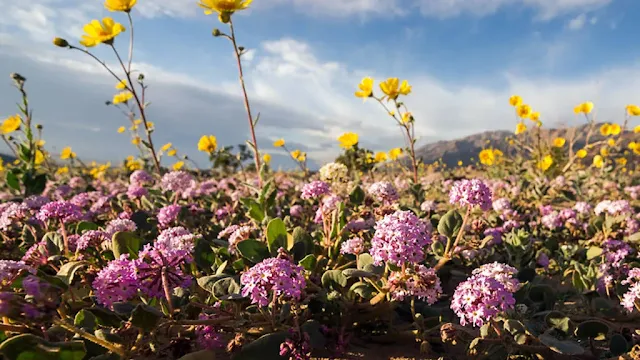The winter months, the best wildflower places in the U.S. can be fun for a while, but once the holiday cheer wears off and February rolls around, spring can't come fast enough. As the chill finally fades and temps begin to rise, Mother Nature is known to put on a stunning floral display. After all, there's no greater sign that spring has finally arrived than the first sight of flowers blooming.
Wildflowers sprout so prolifically and vibrantly in many spots across the best wildflower places in the U.S. country that people travel out of their way just to see wildflowers in the U.S. So, if you're looking to take a spring flower destination and get into nature, we have rounded up the absolute best places to see wildflowers in the US. Watch as hues of the rainbow take over hills in California, the mountains in Idaho, and meadows in Colorado. While many blooms start in springtime, flowers can pop up in places as late as July. Before you go, make sure to bookmark handy wildflower trackers, and wherever you visit, it's important to respect nature by staying on designated paths and taking pictures rather than picking flowers.
Where to see wildflowers in the U.S.
1. Sun Valley in the U.S
What to see: Sun Valley may be known primarily as a winter Seasonal wildflower display destination for its excellent skiing and snowboarding, but the area blooms to life in the spring and summer. Watch as Proctor and Bald Mountains are blanketed with varying shades of color, like the vibrant yellow of Arrowleaf Balsamroot, vibrant pink Fireweed, and white Western Spring Beauty.
2. Anza-Borrego Desert State Park
When to go: February–March
What to see: Superbloom has caused Anza-Borrego Desert to go viral in years past, and the state park is still at the top of our list for wildflowers. With another wet winter in California and a visit to colorful meadows in the U.S. this SoCal desert is likely to see desert gold poppies, phacelia, and a variety of tiny belly flowers flourish this spring. As for where to see them, each canyon—Borrego Palm Canyon, Henderson Canyon Road, and Coyote Canyon—offers different varieties.
3. Shenandoah National Park in the U.S
When to go: Mid-March through summer
What you'll see: If you want rushing waterfalls and scenic backcountry camping along with your wildflowers, then look no further than Shenandoah National Park with wildflowers. A trip along gold-view-guaranteed Skyline Drive makes for the perfect intro to the wildflower scene—a wash of bloodroot, trillium, violets, geraniums, and pink lady slippers—before you set off to explore some of the 500 miles of trails mapping the wilderness.
4. Antelope Valley California Poppy Reserve
When to go: Mid-March to early May
What you'll see: Poppies are beautiful when they cover the desert hillsides in orange flowers. But poppies are also fickle. The Antelope Valley California Poppy Reserve can only expect a moderate poppy season if there's too much rain. Too dry? Not a great bloom either. But that doesn’t mean you won’t see other wildflowers. Peak poppy season is late March to early May—bloom time changes every year.
5. Hill Country in the U.S.
When to go: April
What you'll see: Every spring, Texas turns blue. As in bluebonnets. Across Hill Country, you'll see 800,000 acres of highway-colorful meadows in the U.S. blossoms, but for the best wildflower vistas, you'll need to stay in the car. The Bluebonnet Trail, which includes the cities of Brenham and Chappell Hill, runs for 80 miles through fields and fields of bluebonnets, mingling with Texas paintbrushes, winecups, and primrose for a gloriously scenic drive.
6. Great Smoky Mountain National Park
When to go: Mid-to-late April
What you'll see: The most visited national park with wildflowers in the country and one of the best things to do in Tennesse, the Great Smoky Mountains is home to 1,778 species of animals (the most of any park), more than 2,600 different plant species, and an incredible 1,500 wildflower varieties! You can spot trillium, lady slipper orchids, and violets in the spring, while summer brings black-eyed Susans. The annual Spring Wildflower Pilgrimage usually takes place in April, when visitors can enjoy guided walks and photography workshops.
7. Columbia River Gorge in the U.S
When to go: Late March to early May
What you'll see: This 80-mile-long river canyon—which winds through the Pacific Northwest and spills into the Pacific Ocean—is stunning year-round, but come spring, it really shows off. With more than 800 species of wildflowers, the most prominent are soft-purpled lupine and bright yellowed hawkweed. With such a large area and countless hiking trails, it's smart to check the online map that tracks where wildflowers are blooming before you head out to see them.
8. Sugar Hill with wildflowers
When to go: Early June
What you'll see: The small village of Sugar Hill, New Hampshire—tucked away in a quiet corner of the White Mountains—becomes a tourist attraction for one month every year for one very specific reason: lupines. The town's vast fields, farms, and gardens overflow every June with large purple and pink flowers.
9. Glacier National Park with wildflowers
When to go: June–July
What you'll see: Established in 1910, massive Glacier National Park—it takes up more than one million acres—is older than the national park system itself and boasts one of the world’s most beautiful landscapes—and that includes wildflowers. Every summer, more than a thousand species of wildflowers take over the aspen groves, alpine tundras, lowlands, and steep mountain slopes that make up this gorgeous park. Keep your eyes peeled for purple asters, Indian pipes, geraniums, buttercups, and much more.
10. Death Valley in the U.S.
When to go: Mid-February to mid-July
What you'll see: If it's seeing a super bloom that you're after, head to Death Valley National Park on a good year. And by good year, we mean a year where weather conditions have been perfect enough to create the stunning wildflower displays that occur here ever so often to much fanfare. While it's still too early to say whether this year will be a super bloom—though signs are pretty promising—even if it's not, the annual sightings of wildflowers are still lovely to witness.
11. Crested Butte
When to go: July
What you'll see: The Wildflower Capital of Colorado lives up to its name with hills full of lilies, primrose, honeysuckle, iris, marigolds, and hundreds of other blooms. Usually, the area holds a wildflower festival, but you can still use the festival’s trusty little alpine and subalpine field guides to scour the hills for colorful buds yourself. Use the bloom locator for suggestions on peak times and places to catch your favorite flowers.
12. Fort Pierre National Grassland
When to go: Summer
What you'll see: The lack of roads in Fort Pierre National Grassland makes it even better for peeping wildflowers. Lace up your hiking boots, and you'll be rewarded with various flowers, including purple prairie clover, bluebell, and silver bladderpod. And keep your eyes peeled for other wildlife that calls the grasslands home, such as black-tail prairie dogs, badgers, coyotes, rattlesnakes, burrowing owls, raptors, jackrabbits, mule and whitetail deer, and antelope.
Read more about: The best places to see cherry blossoms in the U.S
Conclusion
The best places to see wildflowers in the U.S. showcase the diverse beauty of nature across the country. Every nature seasonal wildflower displays enthusiast is enthralled by the stunning views seen in these locations, which range from the alpine meadows of Mount Rainier National Park with wildflowers to the colorful blossoms of Texas Hill Country. The breathtaking seasonal wildflower displays serve as a reminder of the distinctive landscapes that make the United States so wonderful, whether you're hiking through flower-viewing places vibrant fields or just taking in the surroundings. To fully appreciate the breathtaking splendor of these floral treasures, schedule your visit during the busiest bloom seasons in the U.S.


















0 Comments